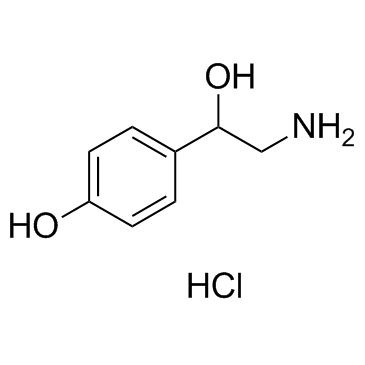770-05-8
| Name | Octopamine hydrochloride |
|---|---|
| Synonyms |
Benzenemethanol, α-(aminomethyl)-4-hydroxy-, hydrochloride (1:1)
Octopamine hydrochloride 4-(2-amino-1-hydroxyethyl)phenol hydrochloride Octopamine HCL UNII:37YAS5L9HQ (±)-Octopamine hydrochloride DL-Octopamine hydrochloride EINECS 212-216-4 MFCD00012881 4-(2-Amino-1-hydroxyethyl)phenol hydrochloride (1:1) Octopamine (hydrochloride) |
| Description | Octopamine Hydrochloride is an endogenous biogenic amine that is closely related to norepinephrine, and has effects on the adrenergic and dopaminergic systems.Target: Dopamine Receptor; Adrenergic ReceptorOctopamine is present in relatively high concentrations in neuronal as well as in non-neuronal tissues of most invertebrate species studied, and modulates almost every physiological process. Octopamine acts as neurohormone including desensitization of sensory inputs, influence on learning and memory, or regulation of the mood of the animal in the central nervous system. Octopamine is the only neuroactive non-peptide transmitter whose physiological role is restricted to invertebrates, and all octopamine receptors belong to the family of G-protein coupled receptors [1].Octopamine (10 μM) injected into the mushroom body (MB) calyces or the antennal lobe but not the lateral protocerebral lobe produces a lasting, pairing-specific enhancement of extension of the proboscis. Octopamine (10 μM) injected into the MB calyces results in an additional pairing-specific effect, because it does not lead to an acquisition but a consolidation after conditioning [2]. Octopamine treatment significantly elevates levels of octopamine in the brain and caused a significant dose-dependent increase in the number of new foragers. Octopamine treatment is effective only when given to bees old enough to forage, i.e., older than 4 days of age. Octopamine influences division of labor in honey bee colonies [3]. |
|---|---|
| Related Catalog | |
| References |
[1]. Roeder, T., Octopamine in invertebrates. Prog Neurobiol, 1999. 59(5): p. 533-61. |
| Boiling Point | 360.7ºC at 760 mmHg |
|---|---|
| Melting Point | ~170 °C (dec.)(lit.) |
| Molecular Formula | C8H12ClNO2 |
| Molecular Weight | 189.639 |
| Flash Point | 172ºC |
| Exact Mass | 189.055649 |
| PSA | 66.48000 |
| LogP | 1.88660 |
| Storage condition | Desiccate at RT |
| Stability | Stable. |
| Water Solubility | soluble |
| Symbol |

GHS07 |
|---|---|
| Signal Word | Warning |
| Hazard Statements | H302 + H312 + H332 |
| Precautionary Statements | P280 |
| Personal Protective Equipment | dust mask type N95 (US);Eyeshields;Gloves |
| Hazard Codes | Xn:Harmful |
| Risk Phrases | R20/21/22 |
| Safety Phrases | S36 |
| RIDADR | 3249 |
| WGK Germany | 3 |
| Packaging Group | III |
| Hazard Class | 6.1(b) |
| HS Code | 2922199090 |
| Precursor 0 | |
|---|---|
| DownStream 2 | |
| HS Code | 2922199090 |
|---|---|
| Summary | 2922199090. other amino-alcohols, other than those containing more than one kind of oxygen function, their ethers and esters; salts thereof. VAT:17.0%. Tax rebate rate:13.0%. . MFN tariff:6.5%. General tariff:30.0% |




